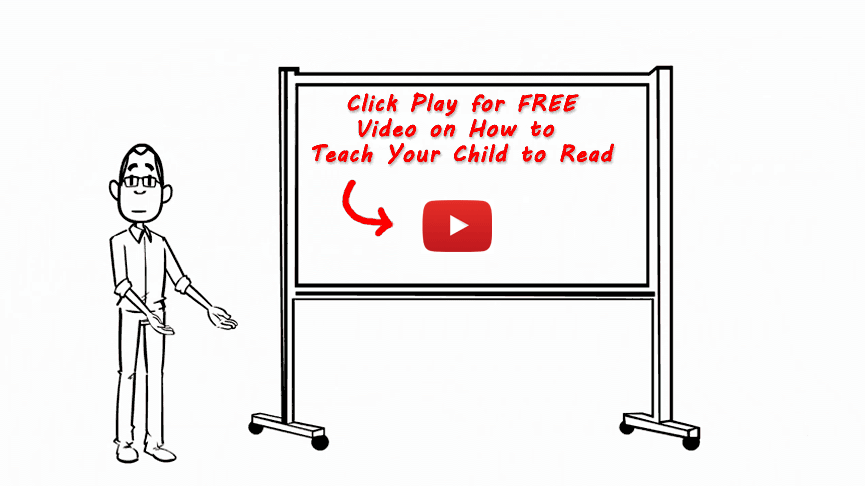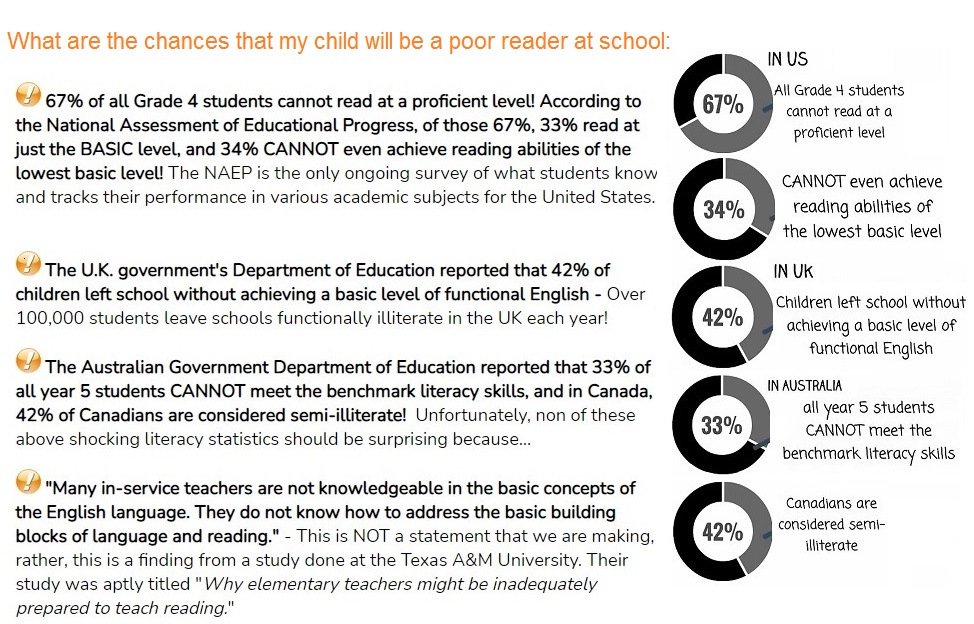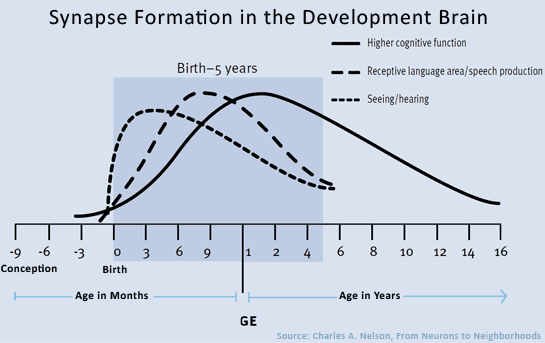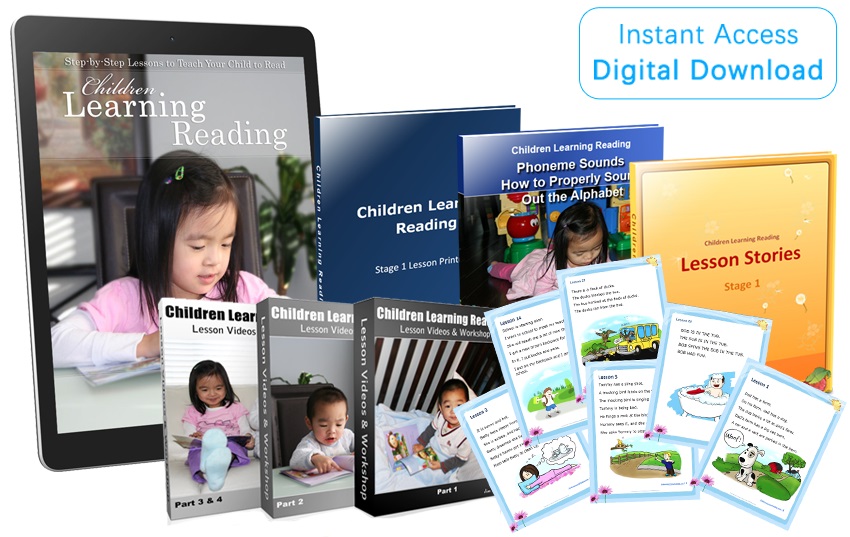Why is Phonics so important in teaching your child to read?
Phonics: Mastering the skill that matters
Every parent wants their child to learn how to read efficiently and so does the teacher when it comes to their students. After all, the ability to read has truly become a necessity to survive and thrive in society today. It has been proven that using phonics for kids is the best way for a child to learn to read.
There are 44 phonic sounds in the English language and you need to introduce all of these sounds to your child. It is all about sounding out words and you can introduce the sounds one at a time. As soon as the first 4 sounds have been learned by your child they can begin to read.
Your child will need to memorize a series of phonics rules and then apply these rules when confronted with new words that need sounding out. For example your child will need to learn when a silent “e” is present in a word.
5 Year Old Child Reading a “Technical” Book! (She Learned to Read Using Jim Yang's Phonics Reading Program)
After a while your child will learn all of the phonics sounds and it will become automatic to them. They will be able to see the letters in a word and be able to say the sounds straight away. Once your child knows all of the phonic sounds they will be able to read proficiently.
Once you believe that your child has mastered the use of phonics and word decoding it is a good idea to perform a phonics assessment to see if they can make the correct sound for every letter and word that they are presented with.
If you want your child to be a fluent reader then phonics lessons are the best way to do this. Not only do you want to encourage your child to read quickly but you want them to be able to read accurately.
Your child will find that reading comes easy to them if they have been learning phonics. It will improve their reading accuracy as well as the speed at which they can read. As the phonics skills of your child develop so will their reading comprehension.
The improvement in comprehension comes from the ability of your child to be able to pronounce all of the words that they see correctly. They will increase their understanding of these words and their vocabulary will also increase.
The synapse formation in a child's brain at different ages
The Role Of Synthetic Phonics
Synthetic phonics is a method of teaching a child to read that virtually ensures that your child can learn to read quickly and proficiently. Your child will be taught the corresponding similarities between phonemes (sounds) and letters.
Your child will be able to identify and blend the different letter sounds and the combinations of letters together to complete a word. The letters are synthesized. As an example your child would pronounce each phoneme in “cat” /c/, /a/ and /t/ and then blend them to produce the word.
These are the first crucial steps for your child to take when learning to read. Once they have mastered phonics they will be able to spell most of the new words that they hear. By using a systematic synthetic phonics approach almost all children will become independent and confident readers quickly.
Your child will move away from mechanically identifying and blending the letter sounds (known as decoding) and begin to read fluently even when they are confronted with words they have never seen or heard before.
Studies Support The Importance Of Synthetic Phonics Teaching
A National Reading Panel was established in the USA to assess the effectiveness of the different approaches that are used to teach children to read. The panel looked at the different approaches for two years and a key area of interest was the role of using phonics to teach reading to children.
It was concluded by the panel that the systematic teaching of phonics produced significant benefits for children in kindergarten all the way to the end of primary school and was also the best approach for children that had reading difficulties[1].
The study found that teaching with systematic synthetic phonics had a positive and significant effect on the reading skills of younger children and also those children that were experiencing reading difficulties.
In 2004 Johnston and Watson carried out two experiments in the United Kingdom to understand the effects of synthetic phonics teaching on reading and spelling attainment. They organized one controlled trial and one randomized controlled trial.
The experiments concluded that with a systematic synthetic phonics approach children were able to read and spell much better than those children that were taught using alternative methods.
It was discovered that with synthetic phonics teaching, children had a word reading skill 3 years and 6 months higher than average for their age and a spelling ability almost two years higher than the average for their age.
Why You Need To Choose A Phonics Program To Teach Your Child To Read
The processes by which a child comprehends spoken language are the same as those by which they comprehend words printed on a page. The difference is that spoken language relies upon hearing the words whereas reading is all about seeing the words written down.
If a child can speak and is aged between 2 to 7, then they have already made considerable progress with their language development and this will equip them well when they start to learn to read. With a high quality phonics program such as Jim Yang’s Children Reading Learning, your child will secure the critical skills of word recognition.
Once word recognition has been mastered your child will be able to read fluently and automatically which will enable them to concentrate on the meaning of the text. The learning of phonic skills for reading is a time limited process compared to the ability of understanding and appreciating the meaning of written text which continues throughout a person’s life.
Phonics Reading Will Develop Your Child’s Overall Reading Skills
Phonics is a fundamental literary element that provides a solid foundation for any child to learn how to read. Without learning this crucial principle, a child would never successfully be able to master speaking and reading words fluently. It is crucial to learn the phonics alphabet and to be able to utilize this skill to master reading any word correctly.
It is through phonics that a child just beginning to read learns to first identify the letters, then associate each letter or groups of letters with its correct sounds, and soon after, through the process of blending they learn how to merge the sounds together to form a complete word. This step, when mastered, will help beginners to become proficient readers.

The reason why you need to teach your child to read while they'll learn to read at school
Phonics And Phonemic Awareness
Learning phonics will develop a better sense of phonemic awareness in your child’s mind. Helping your child to develop phonemic awareness abilities is the most essential step in acquiring reading skills[2]. Every word consists of individual parts which your child can sound out and these are known as phonemes and they are at the heart of phonics teaching.
When these are combined together it helps the children decode basic to complex words, articulate new words clearly and correctly, spell the words right, and become adept at reading full sentences, paragraphs and pages smoothly.
Here’s a short video clip of a 4 year old girl reading story books. Children Learning Reading, which is a powerful and comprehensive phonics and phonemic awareness based reading program, helped her read her favorite stories confidently at such a young age.
Phonics Teaching Strategies
When using phonics to teach reading skills, you will achieve superior results if you make it fun. Fun with phonics can be achieved in a variety of ways and there are many phonics games available.
As a parent, or teacher trying to teach a child how to read, there are three fundamental rules you should keep in mind:
- Always make sure that the reading material is interesting and fun. Whether the materials are stories, poems or rhymes, the child should be excited about reading. Using text with accompanying illustrations is perfect for this.
As you can see in the children learning reading program reviews, each lesson activity is exciting and inspires the kids to want to read. The program also includes vibrant and colorful illustrations.
. - Children learn the best when they think of the process as fun and enjoyable. Do not force them into completing their reading task, because then they would think of the event as a chore rather than a rewarding experience.
If it is seen as a chore they wouldn’t put their best effort into it. With patience and the use of some creativity you can make the lessons fun so they look forward to it the next day.
. - Teaching how to read involves multiple steps, but the most basic one is helping them to master phonemes, which basically refers to the distinct units of individual sounds that make up a word.
Once you teach them the basic alphabet and the corresponding sounds of each letter, then you can focus on teaching them to blend those sounds to form the whole word. It is a systematic progression. After words, they learn how to read sentences, then pages, and eventually an entire story. Consistently practicing these skills will help them to decode and pronounce any words accurately. Then when they discover a new word, they would automatically know what to do to pronounce it correctly.
How to use blending sounds to teach your child phonics
It takes no more than 10-15 minutes per day to teach the child how to correctly use phonics. Rather than making them sit for the whole 15 minutes, plan smaller sessions of 5 minutes each spanning throughout the day. Make sure to keep it short especially when you are teaching a very young child. For older kids each session can be longer. But a few minutes a session is all that is necessary.
Now, the best way to start teaching your child phonics and phonemic awareness is through ear training. Develop the knowledge in them that every word is composed of individual units of sounds, or phonemes. Short sessions of a few minutes are all that you need to help develop this awareness in them. The key is consistency.
How To Teach Phonics At Home
In your everyday conversations with your child, speak the words slowly and clearly. By doing this you are showing the child how each word is made up of several sounds. Stretch the word and stress the sounds slowly. For example, “That p-o-t is h-o-t.” If the separation makes it hard for your child to recognize the word, trying blending the sounds more. For example, instead of d-r-i-n-k, use dr-ink.
You can use this technique on any word. Make it a game. Say a word slowly and distinctly, and ask your child if they understand what you mean.
S-u-n S-un Ssunnnnn
T-a-b-l-e Ta-ble Tttaaabbblle
W-a-l-k W-alk Wwwaalkkk
Do this as frequently as you can. Avoid saying the letter, instead use the correct sound. This will help significantly with ear training. Ever if you think they have mastered the concept of phonics and phonemic awareness, continue using this technique.

Some kids might pick this up within days, for some it might take weeks or months. But don’t give up. Be consistent and frequent with your efforts. Blending the sounds together to recognize the word can take time, but with enough practice it will happen. Do this with every word, regardless of its difficulty.
To have the best chance to teach your child to read fast and fluent, you can use an excellent step by step phonics based reading program like Jim Yang’s Children Learning Reading. Find out about this program here.
Notes:
[1] National Institute of Child Health and Human Development. (2000). Report of the National Reading Panel. Teaching children to read: An evidence-based assessment of the scientific research literature on reading and its implications for reading instruction
[2] Cognition. 1991 Sep;40(3):219-49.
The relationship of phonemic awareness to reading acquisition: more consequence than precondition but still important.
Wimmer H, Landerl K, Linortner R, Hummer P.
University of Salzburg, Austria.







Phonics is one of the main methods of developing children’s reading skills. Phonics helps learners of a new language break words down into individual syllables, improving accuracy in pronunciation. By the way nice article! Very informational.
very beneficial
Its v informative….thank u soo much
Wanna get the book
All of this is spot on! Don’t forget about sound games in the toddler/preschool years, though. They can be so helpful in getting kids reading quickly!
I like that you pointed out that the children should have at least 15 minutes of phonics lesson per day. I will keep that in mind so that I will help my child with the right way to teach him how to read.